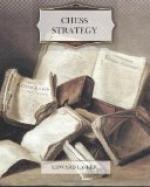--------------------------------------- 8 | | | | | | | | | |---------------------------------------| 7 | | | | | | | | | |---------------------------------------| 6 | | | | * | | * | | | |---------------------------------------| 5 | | | * | | | | * | | |---------------------------------------| 4 | | | | | ^Kt| | | | |---------------------------------------| 3 | | | * | | | | * | | |---------------------------------------| 2 | | | | * | | * | | | |---------------------------------------| 1 | | | | | | | | | --------------------------------------- A B C D E F G H
Diag. 2.
If a player succeeds in reaching the eighth rank with one of his pawns he is entitled to call for any piece of higher grade, with the exception of the King, in place of such pawn.
Each move in a game of chess consists of the displacement of one piece only, with the exception of what is termed “castling,” in which the King and either Rook can be moved simultaneously by either player once in a game. In castling, the King moves sideways to the next square but one, and the Rook to which the King is moved is placed on the square which the King has skipped over. Castling is only allowed if neither the King nor the Rook concerned have moved before, and if there is no piece between the Rook and King.
Diagram 3 shows a position in which White has castled on the Queen’s side, and Black on the King’s side. Castling is not permitted if the King in castling must pass over a square attacked by a hostile piece. A square (or a piece) is said to be “attacked” when the square (or the piece) is in the line of action of a hostile unit. A square (or a piece) is said to be covered or protected if an opposing piece occupying that square (or capturing the piece) could itself be captured.
When attacking the King it is customary to call “check,” to notify the opponent of the fact; for the attack on the King
--------------------------------------- 8 | | | | #R | | #R | #K | | |---------------------------------------| 7 | #P | #P | | | | #P | #P | #P | |---------------------------------------| 6 | | | #P | | #P | | | | |---------------------------------------| 5 | | | | | | | | | |---------------------------------------| 4 | | | | ^P | | | | | |---------------------------------------| 3 | | | | | | | | | |---------------------------------------| 2 | ^P | ^P | ^P | | | ^P | ^P | ^P | |---------------------------------------| 1 | | | ^K | ^R | | | | ^R | --------------------------------------- A B C D E F G H
Diag. 3.
must be met in some way or other. This can be done by capturing the attacker or by interposing a piece (this is not possible in case of attack by a Knight or a pawn), or lastly by moving the King to a square which is not attacked. The latter must not be done by castling. If it is impossible by any of the three methods above mentioned to avoid the attack upon the King, the King is said to be checkmated, and the game is ended.




